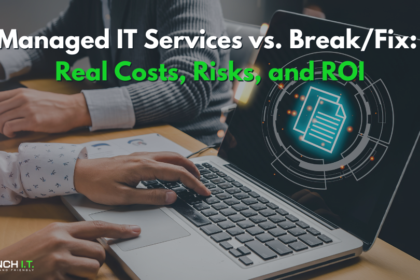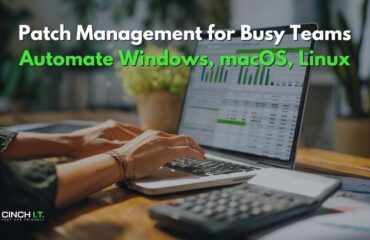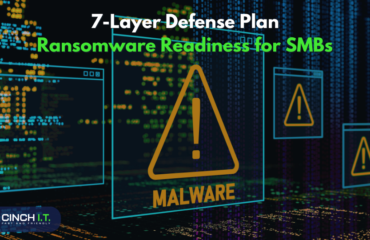
____________________________________________________________________________
Break/Fix (Reactive IT)
In a break/fix model, you call for IT help only when something breaks or you have an issue. There’s no ongoing contract; you pay hourly or per incident. It might feel cost-effective when systems are running smoothly, but it’s unpredictable and reactive. One month you spend $0, the next a server crash might rack up a $2,000 repair bill.
It’s hard to budget, and downtime during those “breaks” can cost you even more in lost productivity. It’s not just the IT spend, but the secondary and tertiary costs that really hurt the business when the tech goes down, leaving employees unable to work.
-
Costs: On the surface, break/fix seems cheaper; you’re not paying unless there’s a problem. However, a single major outage can wipe out those savings. For example, the average cost of IT downtime for a small business runs $8,000–$25,000 per hour due to lost revenue and productivity. With break/fix, you bear that downtime risk and pay a technician by the hour while your team sits idle. Plus, break/fix providers may charge a premium for urgent after-hours support.
-
Risks: Break/fix inherently means waiting until failure. Issues that could have been prevented (like a looming server disk failure or a firewall in need of patching) aren’t addressed proactively. “If it ain’t broke, don’t fix it” rules the day. Unfortunately this can lead to bigger blow-ups. There’s also a misalignment of incentives, the IT company only profits when you have problems. As industry observers note, “service providers win when clients lose” in break/fix. That can mean less motivation to implement long-term fixes. Plus, security can suffer as well. Tasks like software updates or log monitoring might be neglected, leaving you vulnerable to cyber threats.
-
ROI: The ROI on break/fix is hard to measure because it’s essentially gambling on not having issues. There’s no clear return, since money is spent only in a crisis. Any “savings” from not paying a monthly fee can be erased by one big incident. It is not uncommon for small businesses to suffer a ransomware attack and the full recovery services cost over $10,000, which unfortunately, does not include the lost business revenue and employee downtime. All from an attack that could have been prevented with proper controls.
Managed IT Services (Proactive IT)
With managed IT services, such as Cinch IT’s managed services, you pay a flat monthly fee to continuously maintain and support your IT systems. It’s like an all-you-can-eat plan for IT help, with the addition of proactive management. Cinch IT monitors your network, applies patches, supports your users, and proactively works to prevent problems before they disrupt business.
-
Costs: Managed IT services are a predictable cost! You know how much your IT support cost each month (e.g. $X per user or device), making budgeting easier. While it may feel like an added expense during calm times, it often pays for itself by avoiding big break/fix bills and reducing downtime, remediation is always more expensive than prevention. For example, a managed provider might fix a minor server issue in 15 minutes at no extra cost, whereas in break/fix that issue could grow unnoticed and later cost hours of labor. Managed providers also often include software licenses, security tools, or backups in their fee.
-
Risks: Managed IT greatly reduces risk. Your systems are monitored 24/7, majority of issues are caught early or avoided entirely. Patches get applied on time (closing security holes), backups are verified, there’s accountability via service level agreements (SLAs) for response time, and so much more. Your business essentially has an expert team constantly looking after your tech health. When something does go wrong, your managed IT team is on it immediately, often before you even notice. As one MSP-focused study found, unplanned downtime is dramatically lower for companies with proactive monitoring (source: NinjaOne survey). Plus, managed providers and clients share the same goal: no problems. This aligns incentives, a MSP succeeds by keeping you running smoothly, not by racking up hours on emergencies.
-
ROI: The ROI of managed IT services can be measured in avoided costs and improved productivity. Fewer outages and quicker fixes mean your employees can keep working. According to Gartner, tech downtime can cost $5,600 per minute on average for businesses (a figure skewed by larger enterprises). Even for a small business, a few hours of downtime could cost thousands. Managed IT services aim to eliminate most of that downtime. There’s also value in strategic guidance – a good managed IT provider, such as Cinch IT of Denver, helps you plan upgrades and get more from your technology, which can boost your revenue (e.g., smoother systems = better customer service, less employee frustration).

Managed IT services in Denver vs Break and Fix comparison chart
Example:
Consider a local professional firm that switched to managed IT services. They pay a fixed $4,000/month. In the past year, they’ve had zero major outages. Compare that to the prior year on break/fix where they had a server crash and two malware infections which cost them roughly $67,000 in IT repair bills and lost business while systems were down.
By investing ~$48k annually in managed support, they likely saved money overall and avoided headaches. Key Differences at a Glance:
- Predictability: Managed = steady known expense. Break/fix = volatile costs (hard to predict).
- Incentives: Managed provider succeeds when you have fewer issues (shared goals). Break/fix tech profits from problems (opposite goals).
- Downtime: Managed proactively prevents and swiftly resolves outages per an SLA. Break/fix is slower, you call them after things break, enduring more downtime in the interim.
- Security: Managed includes ongoing security updates and monitoring (essential in an era of constant cyber threats), whereas break/fix often leaves security to “when you ask for it.” It’s no wonder 71% of service providers now offer a mix of managed and break/fix, with most moving toward managed due to these advantages.
Which is Right for You?
Most SMBs find that managed IT services provide superior value once they consider hidden costs. Break/fix might be acceptable for very simple setups or when cash flow is extremely tight, but the risk is high. One large unforeseen IT bill or breach can be devastating. Companies relying solely on reactive IT face higher risk of costly downtime and data loss. Managed IT acts like insurance and maintenance in one. You get the peace of mind that professionals are watching over your tech.
If you do choose managed IT services, evaluate providers on their responsiveness, included services, and local reputation. Ask for references and ensure they align with your needs. And if you stick with break/fix, be diligent: schedule regular checkups, keep things updated, perform regular backups, and have a contingency fund for IT emergencies.
____________________________________________________________________________
Managed IT Services vs Break/Fix Summary
Choosing the right IT model can make or break your business performance. For most Denver companies, Managed IT Services deliver predictable costs, stronger security, and better long-term ROI compared to reactive Break/Fix support. With Cinch IT, you gain a proactive managed IT services partner who is dedicated to keeping your systems running smoothly, allowing you to focus on running your business.
____________________________________________________________________________
About The Author
Niko Zivanovich is a Cybersecurity Leader with experience in helping organizations understand and achieve a more complete security posture. He is a co-owner of Cinch IT’s managed IT services in Denver and has been working at Pellera Technology Solutions for 6 years, most recently as the Director of Cyber Defense and Threat Intelligence. Niko specializes in CISO advising, netsec ops, incident response, pen testing, and threat intelligence research. He holds multiple certifications through the SANS GIAC organization and is a Board Director for the InfraGard Colorado and Wyoming Chapter.
Enjoy the Managed IT vs. Break/Fix in Denver: Real Costs, Risks, and ROI article? If so then head over to our Blogs for more top tech tips.
____________________________________________________________________________
About Cinch I.T.
Looking to gain greater control over your technology and security? We specialize in helping businesses like yours take proactive steps with strategic services, including a comprehensive IT Control Checklist Assessment. Our team is committed to being more than just a service provider, we’re your dedicated partner in achieving operational efficiency and peace of mind. With our fast, friendly, and transparent approach, you’ll always know where you stand and how to move forward with Cinch IT.
Discover how Cinch I.T. can support your success through smarter, friendlier, and more secure technology solutions. Contact us today!
Click here to find your nearest local Cinch I.T. office:



